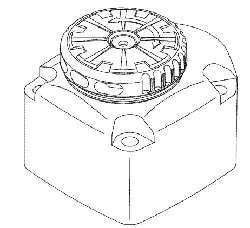Loading ...
Loading ...
Loading ...

SYMPTOM POSSIBLE CAUSE(S) CORRECTIVE ACTION
Trigger cap leaks air 1. O-ring damaged 1. Check and replace damaged O-ring (Fig. 5, No. 24)
2. Valve stem, seal or O-rings damaged 2. Check and replace damaged stem, seal or O-rings
(Fig. 5, Nos. 19, 22, 23 and 24)
Cap leaks air 1. Cap bolts loose 1. Tighten bolts (Fig. 5, No. 2)
2. Damaged O-ring or gasket 2. Check and replace damaged O-ring or gasket
(Fig. 5, Nos. 5 and 7)
Nose leaks air 1. Damaged cylinder O-ring 1. Check and replace damaged O-ring (Fig. 5, No. 16)
2. Damaged bumper 2. Check and replace damaged bumper (Fig. 5, No. 17)
3. Ram guide damaged 3. Check and replace guide (Fig. 5, No. 18)
Tool will not operate 1. Insufficient air supply 1.
2. Damaged or worn head valve O-rings 2.
Tool operates slowly
or loses power
Tool skips fasteners or
inconsistent operation
3. Damaged head valve spring
4. Head valve binding in cap
5. Insufficient lubrication
1. Damaged head valve spring
2. Damaged or worn O-rings
3. Damaged trigger assembly
4. Build-up on ram
5. Cylinder not sealed on bumper
properly
6. Insufficient air supply
7. Insufficient lubrication
8. Head valve poorly lubricated
1. Worn or damaged bumper
2. Build-up on ram or nose
3. Insufficient air supply
4. Damaged or worn piston O-ring
5. Damaged magazine springs
6. Magazine-nose bolts loose
7. Fasteners too short
8. Damaged fasteners
9. Incorrect fastener size
10. Cap leaks
11. Damaged trigger valve seal and
O-rings
12. Bent or damaged ram
13. Dirty magazine
14. Damaged or worn magazine
15. Insufficient lubrication
Check air supply
Replace damaged or worn O-rings
(Fig. 5, Nos. 7 and 10)
3. Replace damaged spring (Fig. 5, No. 6)
4. Clean and lubricate cap and head valve
(Fig. 5, Nos. 4 and 9)
5. Place five or six drops of air tool oil into inlet cap
1. Check and replace damaged spring (Fig. 5, No. 6)
2. Check and replace damaged or worn O-rings
3. Check and replace trigger assembly
4. Clean piston/ram assembly (Fig. 5, No. 13)
5. Disassemble cylinder and assemble properly
6. Check air supply
7. Place five or six drops of air tool oil into inlet cap
8. Disassemble head valve (Fig. 5, No. 9),
clean, lubricate, and assemble properly
1. Check and replace bumper (Fig. 5, No. 17)
2. Clean and lubricate piston/ram assembly
(Fig. 5, No. 13) and inside of nose cover (Fig. 5, No. 43)
3. Check air supply
4. Check and replace O-ring (Fig. 5, No. 14)
5. Check and replace spring (Fig. 5, No. 47)
6. Align nose with magazine and tighten bolts
(Fig. 5, No. 42)
7. Use Sears recommended fasteners only
8. Discard damaged fasteners
9. Use Sears recommended fasteners only
10. Tighten cap bolts (Fig. 5, No. 2). Check and replace
damaged cap O-ring (Fig. 5, No. 7) or gasket
(Fig. 5, No. 5)
11. Check and replace damaged seal and O-rings
(Fig. 5, Nos. 19, 23 and 24)
12. Check and replace damaged piston/ram assembly
(Fig. 5, No. 13)
13. Clean magazine and lubricate with air tool oil
14. Check and replace magazine (Fig. 5, No. 44)
15. Place five or six drops of air tool oil into inlet cap
(Fig. 5, No. 38)
5
Loading ...
Loading ...
Loading ...
